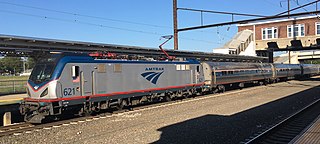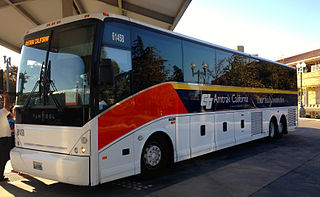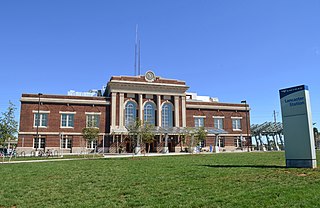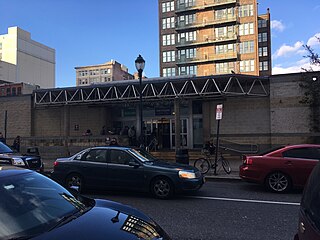
The Keystone Service is a 195 mile regional passenger train service from Amtrak between the Harrisburg Transportation Center in Harrisburg, Pennsylvania, and 30th Street Station in Philadelphia, running along the Philadelphia to Harrisburg Main Line. Most trains continue along the Northeast Corridor (NEC) to Penn Station in New York City.

Fort Worth Central Station is an intermodal transit center in downtown Fort Worth, Texas. It serves two commuter rail lines, two Amtrak intercity rail lines, and Greyhound intercity bus. It also serves as the main transfer center for Trinity Metro, Fort Worth's public bus system.

Baltimore Penn Station, formally named Baltimore Pennsylvania Station in full, is the main inter-city passenger rail hub in Baltimore, Maryland. Designed by New York City architect Kenneth MacKenzie Murchison (1872–1938), it was constructed in 1911 in the Beaux-Arts style of architecture for the Pennsylvania Railroad. It is located at 1515 N. Charles Street, about a mile and a half north of downtown and the Inner Harbor, between the Mount Vernon neighborhood to the south, and Station North to the north. Originally called Union Station because it served the Pennsylvania Railroad and Western Maryland Railway, it was renamed to match other Pennsylvania Stations in 1928.

Union Station, also known as Pennsylvania Station and commonly called Penn Station, is a historic train station in Downtown Pittsburgh, Pennsylvania. It was one of several passenger rail stations that served Pittsburgh during the 20th century; others included the Pittsburgh & Lake Erie Railroad Station, the Baltimore and Ohio Station, and Wabash Pittsburgh Terminal, and it is the only surviving station in active use.

Newark Penn Station is an intermodal passenger station in Newark, New Jersey. One of the New York metropolitan area's major transportation hubs, Newark Penn Station is served by multiple rail and bus carriers, making it the seventh busiest rail station in the United States, and the fourth busiest in the New York City metropolitan area.

Amtrak Thruway is a system of through-ticketed transportation services to connect passengers with areas not served by Amtrak trains. In most cases these are dedicated motorcoach routes, but can also be non-dedicated intercity bus services, transit buses, vans, taxis, ferry boats and commuter rail trains.

Wilmington station, also known as the Joseph R. Biden, Jr., Railroad Station, is a passenger rail station in Wilmington, Delaware. It serves nine Amtrak train routes and is part of the Northeast Corridor. It also serves SEPTA Regional Rail commuter trains on the Wilmington/Newark Line as well as DART First State local buses and Greyhound Lines intercity buses.

Trenton Transit Center is the main passenger train station in Trenton, New Jersey. It is the southernmost stop in New Jersey on the Northeast Corridor. It is the terminus for NJ Transit trains to and from New York City and SEPTA Trenton Line Regional Rail trains to and from Philadelphia, Pennsylvania, and an intermediate station for Amtrak trains traveling between the two cities along the Northeast Corridor.

Springfield Union Station is a train and bus station in the Metro Center area of Springfield, Massachusetts. Constructed in 1926, Springfield Union Station is the fifth-busiest Amtrak station in the Commonwealth, and the busiest outside of Greater Boston.

West Baltimore station is a commuter rail station located in the western part Baltimore, Maryland, along the Northeast Corridor. It is served by MARC Penn Line trains. The station is positioned on an elevated grade at 400 Smallwood Street near parallel West Mulberry and West Franklin Streets extending off U.S. Route 40. Three large surface lots are available for commuters. The station only has staircases from street level and two low-level side platforms next to the outer tracks and is thus not accessible to people with some mobility disabilities, but MTA Maryland plans to renovate the station with accessible platforms and entrances.

Richmond Main Street Station, officially the Main Street Station and Trainshed, is a historic railroad station and office building in Richmond, Virginia. It was built in 1901, and is served by Amtrak. It is also an intermodal station with Richmond's city transit bus services, which are performed by Greater Richmond Transit Company (GRTC). The station is colloquially known by residents as The Clock Tower. It was listed to the National Register of Historic Places in 1970, and in 1976 was made a U.S. National Historic Landmark. Main Street Station serves as a secondary train station for Richmond providing limited Amtrak service directly to downtown Richmond. Several Amtrak trains serving the Richmond metropolitan area only stop at the area's primary rail station, Staples Mill Road which is located five miles to the north in Henrico County.

The Alvarado Transportation Center (ATC) is a multimodal transit hub located at 100 1st Street SW in Downtown Albuquerque, New Mexico. The complex was built as a hub for Albuquerque's regional transit system and as a replacement for Albuquerque's previous bus depot and train station. The center serves ABQ RIDE, Amtrak, Greyhound Lines, and the New Mexico Rail Runner Express commuter rail line.

Capital Area Transit (CAT), also known as rabbittransit Capital Region, is a regional public transportation agency that operates bus and paratransit service in the Harrisburg–Carlisle metropolitan statistical area. Its scheduled route bus service covers much of the southern half of Dauphin County and the eastern half of Cumberland County. It also operates two bus routes into northern York County. CAT's shared ride/paratransit operations serve residents throughout Dauphin County. In 2022, the system had a ridership of 1,200,800.

Lancaster station is an Amtrak railroad station and a former Pennsylvania Railroad station in Lancaster, Lancaster County in the U.S. state of Pennsylvania. Located on the Keystone Corridor, the station is served by the Keystone Service between New York City and Harrisburg, and by the Pennsylvanian between New York and Pittsburgh. Lancaster is the second busiest Amtrak station in Pennsylvania, and the twenty-first busiest in the United States. It is one of the busiest Amtrak stations serving a metropolitan area smaller than two million people, primarily because of the large number of passengers traveling to and from Philadelphia and points east.

Williamsburg Transportation Center is an intermodal transit station in Williamsburg, Virginia. Operated by the Williamsburg Area Transit Authority, it also serves Amtrak's Northeast Regional train as well as Greyhound Lines and Hampton Roads Transit intercity buses. The transportation center was formerly a Chesapeake and Ohio Railway (C&O) passenger station.

Trailways of New York is one of the largest privately held transportation companies based in New York State. It employs over 450 people and carries passengers more than 80 million miles annually.

Columbia Station, also known as Wenatchee station, is an intermodal train and bus station in Wenatchee, Washington, United States. It is a stop on Amtrak's Empire Builder train and is the main hub for Link Transit, the local bus system serving Wenatchee and surrounding areas. The station is also served by intercity buses operated by Grant Transit Authority, Northwestern Trailways, and Travel Washington.

The Philadelphia Greyhound Terminal was the primary intercity bus station in Philadelphia, Pennsylvania. The station's function relocated to 618 Market Street between Sixth and Seventh Streets in Center City Philadelphia. Prior to relocating to its current Market Street location on June 27, 2023, the terminal was located at 1001 Filbert Street in Center City Philadelphia.
Lackawanna Transit Center is the main bus station and a proposed train station in Scranton, Pennsylvania, operated by the County of Lackawanna Transit System (COLTS).

The Grant Street Transportation Center is an intercity bus station and parking garage in downtown Pittsburgh, Pennsylvania. The facility is operated by the Pittsburgh Parking Authority and takes up an entire city block, with the ground floor hosting the bus station and some retail space. Upper floors are dedicated to parking.





























